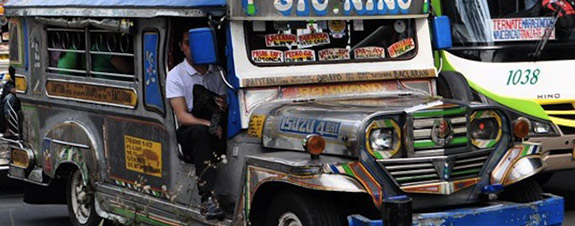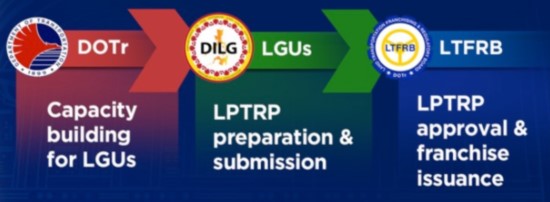
Here is part two of the PUV Modernization program that is to be implemented by DOTr, LTRFB and DILG to all the LGUs in the country. Each LGU will then be required to submit a Local Public Transport Route Plan (LPTRP) and here is the continuation of the content of the document LPTRPM Module for this modernization program.
Joint Memorandum Circular with DILG
“Guidelines on the Preparation and Issuance of Local Ordinances, Orders, Rules and Regulation concerning the Local Public Transport Route Plan (LPTRP)”

Local-Level Public Transport Planning Approach
LGUs are in a better position to identify local public transport service requirements being in-charge of formulating the Comprehensive Land Use Plan, Zoning Plans, and Traffic Management Plans.
Local Public Transport Route Plan
• Make the routes more responsive to passenger demand and determine the appropriate vehicle type depending on road hierarchy and configuration
• LGU initiative (Participatory Planning)
City/Municipal LGU
-Intra-city/Municipality
Provincial Government
-Inter-city/Municipality
-Inter-province
DOTr
-Inter-province/region
-Between and among independent cities
– Inter-city and intermunicipality of MM and adjoining provinces (MUCEP Area)
LPTRP Approval Process

The LPTRP Team
|
LPTRP Team Members |
Role | Data Preparation |
| Local Chief Executive | Chair | Signed Executive Order |
| Head of Transport Committee, Legislative Council | Co-chair | Traffic and Transport Code, Authorized PUV Terminal |
| Local Administrator | Co-chair | Executive-Legislative Agenda, Transport Projects |
| Planning and Development Coordinator | Member | CLUP, CDP Land Use Plan, Demographic Data |
| Head of Tricycle Regulatory Unit (TRU) | Member | Tricycle Franchising Data |
| Head of Traffic Management Office | Member | Traffic Management Plans |
| Head of Engineering Office | Member | Road Infrastructure Data, Base Map |
| Head of Agriculture Office | Member | Farm-to-Market Roads data |
| Head of Tourism Office | Member | Tourism Development data |
| Representative from Local PNP Traffic Group | Member | Traffic Accident Data |
| Representative from Association of Barangay Captain (ABC) | Member | Socio-Economic Data, Road infrastructure data |
| Representative from DPWH District Office | Member | Road infrastructure Data, Base Map |
| Representative from LTO Regional Office/HPG | Member | Vehicle Registration data |
| Representative from LTFRB Regional Office | Member | Approved PUV Franchises |
| Representative from Private Sector (Business, or Transport Group) | Member | |
| Representative from Academe or Non-government Organization | Member |
PUV Modernization – Route Rationalization
Objective: Appropriate mode based on Passenger Demand and Road Hierarchy
Basic Policy: Higher Capacity PUVs assigned to high demand routes
Criteria: The establishment of public transportation routes and the corresponding modes of services shall be based on the following criteria:
– Passenger demand patterns and characteristics
– Road network configuration
– Corresponding road functions (road hierarchy)
– Road capacities
Basic Guideline in Route Planning
“Transportation modes shall follow hierarchy of passenger demand and function of roads”
| No. Of Passengers | Vehicle Type |
| 500 and Below | Filcab |
| 501 – 1000 | Jeepney and UV Express |
| 1001 – 5000 | Mini-Bus |
| 5001 and above | Bus |
Route Connectivity Policy
- For major arterial roads, highways, and expressways, PUBs are the prescribed mode of transport.
- However, PUJs, Filcabs, and UV Express Services may operate on minimal portions of the PUB corridor for the solepurpose of providing intermodal transfers at bus stops, so long as such purpose is indicated in the relevant LPTRP.
New of Developmental Routes
- New routes shall be designed such that overlaps with existing routes do not exceed 25% of the length of any of the affected routes.
- Previously authorized routes may be restructured (i.e., merged with another previously authorized route, or with a new route, or shortened, or split into different routes) due to marked change in trip patterns arising from urban renewal or urban redevelopment projects or resulting from the LPTRP
- For new or developmental routes, a minimum fleet size of 15 units for any type of PUV for 6 months shall be imposed, subject to review by the LTFRB.
- Exceptions to the 25% overlap limit
- New urban development is at least 5 kms. away from the origin or destination of the traditional route.
- Passenger demand in new area > existing route, and can’t be adequately served;
- Additional and/or new sections of a road network are developed, thereby providing shorter and faster trips;
- Other conditions subject to the approval of DOTr
To be continued on Part 3…
